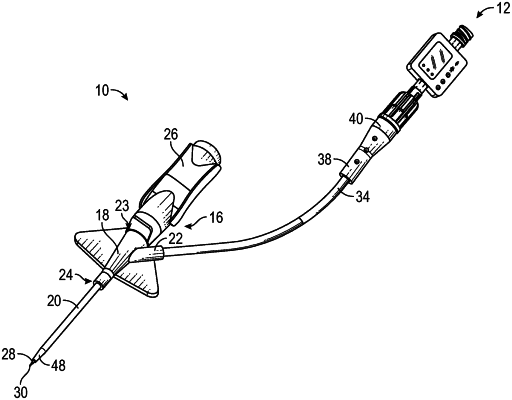| CPC A61M 1/3656 (2014.02) [A61M 1/73 (2021.05); A61M 1/74 (2021.05); A61M 1/86 (2021.05); A61M 5/16831 (2013.01); A61M 39/10 (2013.01); G16H 20/17 (2018.01); A61M 1/734 (2021.05); A61M 2005/16863 (2013.01); A61M 2205/18 (2013.01); A61M 2205/3334 (2013.01); A61M 2205/3553 (2013.01); A61M 2205/50 (2013.01)] | 14 Claims |

|
1. A monitoring device for detecting when a catheter is partially occluded, comprising:
a first housing comprising a planar top surface, a distal end, a proximal end, a wall forming a tunnel extending through the proximal end and the distal end, and a fluid pathway extending through the tunnel, wherein the wall comprises a first hole and a second hole extending therethrough, wherein the distal end comprises a connector configured to couple to a catheter assembly, the first housing further comprising:
a plurality of sensors disposed and spaced apart within the fluid pathway, wherein the plurality of sensors comprises a first sensor disposed within the first hole and a second sensor disposed within the second hole, wherein the first sensor and the second sensor enclose the fluid pathway within the tunnel between the distal end and the proximal end of the first housing;
a first set of electrical contacts that connect to the plurality of sensors and are embedded in the planar top surface; and
a groove in the planar top surface that extends from a first side of the first housing towards a second side of the first housing opposite the first side of the first housing; and
a second housing having a planar bottom surface, the second housing comprising:
a computing system having a processor that is configured to receive data sensed by the plurality of sensors, the processor being configured to detect, from the received data, when the catheter is partially occluded but not yet fully occluded, the computing system further comprising a communication unit by which the processor wirelessly transmits an output signal to a receipt location when the processor detects that the catheter is partially occluded;
a second set of electrical contacts that connect to the computing system, the second set of electrical contacts being embedded in the planar bottom surface; and
a protrusion that extends downwardly from the planar bottom surface, the protrusion extending from a first side of the second housing towards a second side of the second housing opposite the first side of the second housing, the protrusion being configured to slide into the groove in the planar top surface of the first housing to thereby secure the first housing to the second housing, wherein the protrusion and the groove are configured such that, when the protrusion is fully slid into the groove, the planar bottom surface is secured against and aligned with the planar top surface and the second set of electrical contacts align with and contact the first set of electrical contacts.
|